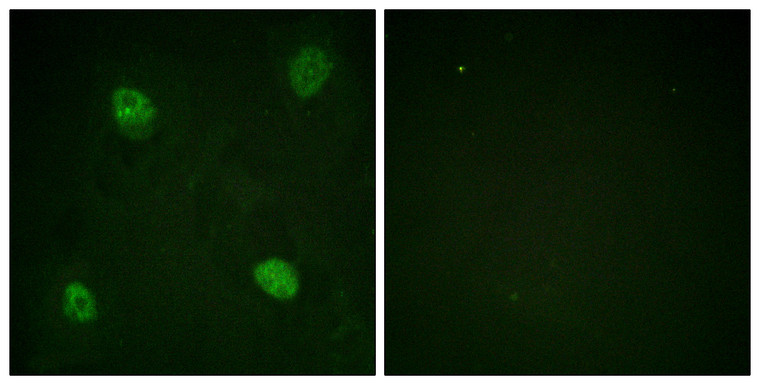| Host: |
Rabbit |
| Applications: |
WB/IHC/IF/ELISA |
| Reactivity: |
Human/Mouse/Rat |
| Note: |
STRICTLY FOR FURTHER SCIENTIFIC RESEARCH USE ONLY (RUO). MUST NOT TO BE USED IN DIAGNOSTIC OR THERAPEUTIC APPLICATIONS. |
| Short Description: |
Rabbit polyclonal antibody anti-Phospho-Heterogeneous nuclear ribonucleoprotein D0-Ser83 (49-98 aa) is suitable for use in Western Blot, Immunohistochemistry, Immunofluorescence and ELISA research applications. |
| Clonality: |
Polyclonal |
| Conjugation: |
Unconjugated |
| Isotype: |
IgG |
| Formulation: |
Liquid in PBS containing 50% Glycerol, 0.5% BSA and 0.02% Sodium Azide. |
| Purification: |
The antibody was affinity-purified from rabbit antiserum by affinity-chromatography using epitope-specific immunogen. |
| Concentration: |
1 mg/mL |
| Dilution Range: |
WB 1:500-1:2000IHC 1:100-1:300IF 1:200-1:1000ELISA 1:20000 |
| Storage Instruction: |
Store at-20°C for up to 1 year from the date of receipt, and avoid repeat freeze-thaw cycles. |
| Gene Symbol: |
HNRNPD |
| Gene ID: |
3184 |
| Uniprot ID: |
HNRPD_HUMAN |
| Immunogen Region: |
49-98 aa |
| Specificity: |
Phospho-hnRNP D0 (S83) Polyclonal Antibody detects endogenous levels of hnRNP D0 protein only when phosphorylated at S83. |
| Immunogen: |
The antiserum was produced against synthesized peptide derived from the human hnRPD around the phosphorylation site of Ser83 at the amino acid range 49-98 |
| Function | Binds with high affinity to RNA molecules that contain AU-rich elements (AREs) found within the 3'-UTR of many proto-oncogenes and cytokine mRNAs. Also binds to double- and single-stranded DNA sequences in a specific manner and functions a transcription factor. Each of the RNA-binding domains specifically can bind solely to a single-stranded non-monotonous 5'-UUAG-3' sequence and also weaker to the single-stranded 5'-TTAGGG-3' telomeric DNA repeat. Binds RNA oligonucleotides with 5'-UUAGGG-3' repeats more tightly than the telomeric single-stranded DNA 5'-TTAGGG-3' repeats. Binding of RRM1 to DNA inhibits the formation of DNA quadruplex structure which may play a role in telomere elongation. May be involved in translationally coupled mRNA turnover. Implicated with other RNA-binding proteins in the cytoplasmic deadenylation/translational and decay interplay of the FOS mRNA mediated by the major coding-region determinant of instability (mCRD) domain. May play a role in the regulation of the rhythmic expression of circadian clock core genes. Directly binds to the 3'UTR of CRY1 mRNA and induces CRY1 rhythmic translation. May also be involved in the regulation of PER2 translation. |
| Protein Name | Heterogeneous Nuclear Ribonucleoprotein D0Hnrnp D0Au-Rich Element Rna-Binding Protein 1 |
| Database Links | Reactome: R-HSA-450408Reactome: R-HSA-72163Reactome: R-HSA-72203 |
| Cellular Localisation | NucleusCytoplasmLocalized In Cytoplasmic Mrnp Granules Containing Untranslated MrnasComponent Of RibonucleosomesCytoplasmic Localization Oscillates Diurnally |
| Alternative Antibody Names | Anti-Heterogeneous Nuclear Ribonucleoprotein D0 antibodyAnti-Hnrnp D0 antibodyAnti-Au-Rich Element Rna-Binding Protein 1 antibodyAnti-HNRNPD antibodyAnti-AUF1 antibodyAnti-HNRPD antibody |
Information sourced from Uniprot.org
12 months for antibodies. 6 months for ELISA Kits. Please see website T&Cs for further guidance









